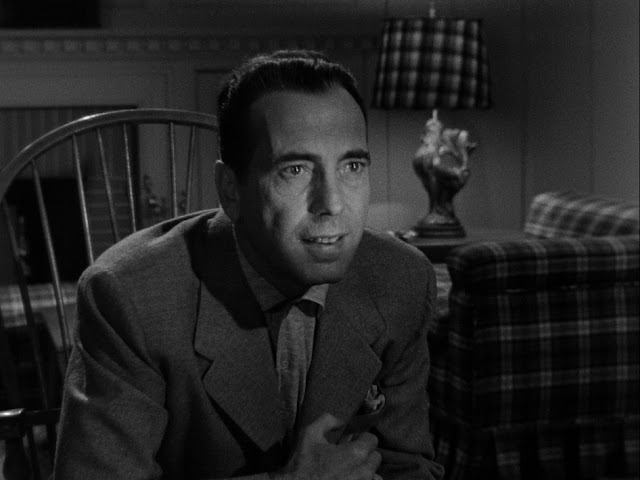But his charisma and brilliance has defied the ages.
Case in point: last week, I was standing in front of a cashier at Chipotle who was probably no older than 18. She glanced at my Casablanca T-shirt adorned with the image of Bogart and Ingrid Bergman in one of their oh-so-romantic clinches.
“I just saw that last night,” said the cashier, pointing at the T-shirt. “I loved it. I love romantic films.”
Jessie Maltin, who hosts the popular Maltin on Movies podcast with her father Leonard Maltin, believes Bogart is very much a star for young filmgoers today.
“I think he’s quintessentially cool,” she said. “I’ve talked to a lot of young people about watching old movies and a lot of times, they’re nervous because they’ve been told that this or that is the greatest thing ever made. No one should be told something is brilliant; they have to experience it. “
What she’s discovered talking to millennials is that “with him, it takes very little convincing. As soon as you see him, he’s cool. He’s got that je ne sais quoi. He’s got that something about him that you can’t look away. I feel like it never goes away, it never changes. People are always taken with him.”
Maltin finds it amazing in pop culture terms “even if someone doesn’t know his name, most people can identity him by his face. They’ll know ‘that’s the guy.’ A trench coat and a fedora, immediately everyone goes 'that’s the guy.'”
In fact, nobody could wear a trench coat better than Bogart, or pull off such snappy patter as this classic line from 1946’s The Big Sleep:
“I don’t mind if you don’t like my manners, I don’t like them myself. They are pretty bad. I grieve over them on long winter evenings.”
And though far from traditionally handsome like such peers as Clark Gable, Gary Cooper, Errol Flynn, and Tyrone Power, Bogart became a romantic idol in 1942’s “Casablanca” and furthered that image when he fell in love with - and married - his beautiful young To Have and Have Not co-star Lauren Bacall. The couple went on to make three more films together, and a TV version of his 1936 hit The Petrified Forest.
Bogart’s coolness, versatility and daring are on display in the Aero’s Theatre's upoming series “Humphrey Bogart, Hollywood Legend,” which begins July 19 with Nicholas Ray’s exceptional 1950 noir In a Lonely Place, in which he plays a hot-tempered screenwriter accused of murder, and 1952’s compelling Richard Brooks newspaper drama Deadline U.S.A.
Other films in the series illustrate not only the extraordinary output of classic films in which he starred, but the varied roles that he played over the years. They range from the ruthless gangster Duke Mantee in The Petrified Forest (July 26) to film noir icon opposite Bacall in 1948’s Key Largo (July 21) 1946’s The Big Sleep (July 27) To Have and Have Not and 1947’s Dark Passage (July 28) to romantic comedy in 1954’s Sabrina (July 22) and 1951’s The African Queen (July 29), for which he won his only Oscar.
Also included is his best-loved film, Casablanca (July 20), for which he earned his first Oscar nomination, and his stunning Oscar-nominated performance as the mentally unraveling, strawberry-craving Captain Queeg in 1954’s The Caine Mutiny.
The series also showcases the acclaimed directors with whom Bogart collaborated, including John Huston (who directed five films in the series), Howard Hawks, Raoul Walsh, Michael Curtiz, and Billy Wilder.
Bogart, who was named by the American Film Institute as the number one male star of the 20th century, has always appealed to young generations. Back in 1967, Harvard University began screening Casablanca and the mystique of Bogart quickly became part of the pop culture landscape with books, posters, T-shirts, and festivals. Woody Allen scored a big hit on Broadway in 1969 with the comedy Play It Again, Sam and the 1972 film version, in which the spirit of Bogart advises the hapless protagonist on matters of life and love.
Film historian and author Mark A. Vieira (George Hurrell’s Hollywood: Glamour Portraits 1925-1992) noted there are many reasons why Bogart has stayed relevant. “His looks are so individual. He doesn’t have that Brilliantine look of the early ‘30s. Though he has a hair piece, he doesn’t’ have that kind of glued-together look of the 1940s lug. One thing that occurred to me - I was just thinking about his yesterday - he was an angry person, I think that comes through. I think people can relate to that.”
He may have been angry, but Bogart wasn’t afraid to show his vulnerability, especially as café owner Rick Blaine in Casablanca when his former love Ilsa (Bergman) walks back into his life. “He’s wounded, too,” said Vieira. “I think people also responded to the undercurrent of hurt, vulnerability and anger.”
Casablanca is the Bogart film Maltin has the biggest emotional connection to because it is her father’s favorite film.
“It’s a childhood thing,” she said. “My dad has shown it to me so many times. I’m watching it with him and watching him love it over and over again. It brings him such joy.”
Veteran journalist Susan King wrote about entertainment at the Los Angeles Times for 26 years (January 1990 - March 2016), specializing in classic Hollywood stories. She also wrote about independent, foreign and studio movies and occasionally TV and theater stories. She received her master's degree in film history and criticism at USC. After working 10 years at the L.A. Herald Examiner, she moved to the Los Angeles Times.




